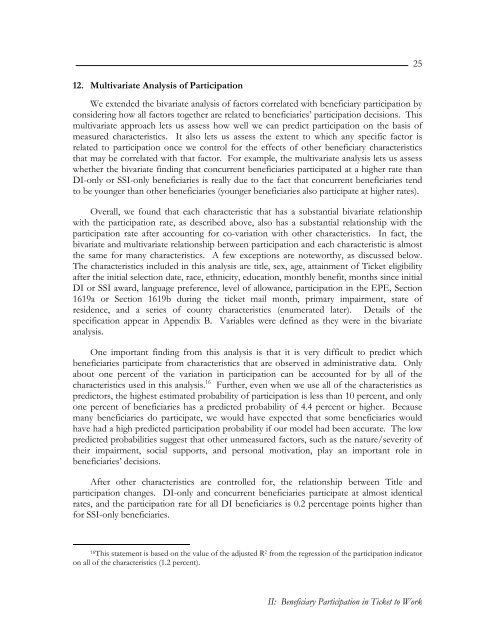Evaluation of the Ticket to Work Program, Implementation ...
Evaluation of the Ticket to Work Program, Implementation ...
Evaluation of the Ticket to Work Program, Implementation ...
Create successful ePaper yourself
Turn your PDF publications into a flip-book with our unique Google optimized e-Paper software.
2512. Multivariate Analysis <strong>of</strong> ParticipationWe extended <strong>the</strong> bivariate analysis <strong>of</strong> fac<strong>to</strong>rs correlated with beneficiary participation byconsidering how all fac<strong>to</strong>rs <strong>to</strong>ge<strong>the</strong>r are related <strong>to</strong> beneficiaries’ participation decisions. Thismultivariate approach lets us assess how well we can predict participation on <strong>the</strong> basis <strong>of</strong>measured characteristics. It also lets us assess <strong>the</strong> extent <strong>to</strong> which any specific fac<strong>to</strong>r isrelated <strong>to</strong> participation once we control for <strong>the</strong> effects <strong>of</strong> o<strong>the</strong>r beneficiary characteristicsthat may be correlated with that fac<strong>to</strong>r. For example, <strong>the</strong> multivariate analysis lets us assesswhe<strong>the</strong>r <strong>the</strong> bivariate finding that concurrent beneficiaries participated at a higher rate thanDI-only or SSI-only beneficiaries is really due <strong>to</strong> <strong>the</strong> fact that concurrent beneficiaries tend<strong>to</strong> be younger than o<strong>the</strong>r beneficiaries (younger beneficiaries also participate at higher rates).Overall, we found that each characteristic that has a substantial bivariate relationshipwith <strong>the</strong> participation rate, as described above, also has a substantial relationship with <strong>the</strong>participation rate after accounting for co-variation with o<strong>the</strong>r characteristics. In fact, <strong>the</strong>bivariate and multivariate relationship between participation and each characteristic is almost<strong>the</strong> same for many characteristics. A few exceptions are noteworthy, as discussed below.The characteristics included in this analysis are title, sex, age, attainment <strong>of</strong> <strong>Ticket</strong> eligibilityafter <strong>the</strong> initial selection date, race, ethnicity, education, monthly benefit, months since initialDI or SSI award, language preference, level <strong>of</strong> allowance, participation in <strong>the</strong> EPE, Section1619a or Section 1619b during <strong>the</strong> ticket mail month, primary impairment, state <strong>of</strong>residence, and a series <strong>of</strong> county characteristics (enumerated later). Details <strong>of</strong> <strong>the</strong>specification appear in Appendix B. Variables were defined as <strong>the</strong>y were in <strong>the</strong> bivariateanalysis.One important finding from this analysis is that it is very difficult <strong>to</strong> predict whichbeneficiaries participate from characteristics that are observed in administrative data. Onlyabout one percent <strong>of</strong> <strong>the</strong> variation in participation can be accounted for by all <strong>of</strong> <strong>the</strong>characteristics used in this analysis. 16 Fur<strong>the</strong>r, even when we use all <strong>of</strong> <strong>the</strong> characteristics aspredic<strong>to</strong>rs, <strong>the</strong> highest estimated probability <strong>of</strong> participation is less than 10 percent, and onlyone percent <strong>of</strong> beneficiaries has a predicted probability <strong>of</strong> 4.4 percent or higher. Becausemany beneficiaries do participate, we would have expected that some beneficiaries wouldhave had a high predicted participation probability if our model had been accurate. The lowpredicted probabilities suggest that o<strong>the</strong>r unmeasured fac<strong>to</strong>rs, such as <strong>the</strong> nature/severity <strong>of</strong><strong>the</strong>ir impairment, social supports, and personal motivation, play an important role inbeneficiaries’ decisions.After o<strong>the</strong>r characteristics are controlled for, <strong>the</strong> relationship between Title andparticipation changes. DI-only and concurrent beneficiaries participate at almost identicalrates, and <strong>the</strong> participation rate for all DI beneficiaries is 0.2 percentage points higher thanfor SSI-only beneficiaries.16 This statement is based on <strong>the</strong> value <strong>of</strong> <strong>the</strong> adjusted R 2 from <strong>the</strong> regression <strong>of</strong> <strong>the</strong> participation indica<strong>to</strong>ron all <strong>of</strong> <strong>the</strong> characteristics (1.2 percent).II: Beneficiary Participation in <strong>Ticket</strong> <strong>to</strong> <strong>Work</strong>
















